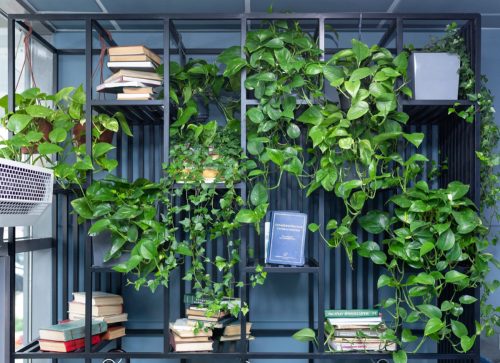The 5 Best Houseplants for Hanging Planters, Experts Say

Houseplants can easily brighten up a room and improve your mood— so much so that you may find yourself running out of space to put them! If this sounds familiar, you might want to consider hanging planters. “Hanging plants are brilliant for drawing eyes upwards, making your room feel taller, and styling hard-to-reach spaces,” says Alick Burnett, managing director at Blooming Artificial. But which houseplants are best for hanging planters? Keep reading to hear from plant experts about their top recommendations and plant-care tips.
RELATED: 8 Easy Houseplants That Don’t Need Sunlight.
The 5 Best Houseplants for Hanging Planters
1. Pothos

There are many varieties of pothos, and almost any of them are ideal for a hanging basket.
“It’s a natural trailer, and most varieties grow quickly when you have them in the right spot,” says Erinn Witz, a garden expert and co-founder of Seeds and Spades.
Witz specifically recommends the marble queen pothos. “It’s a perfect balance of many attributes: interesting variegated foliage, super-easy care, and fast growth.”
Alex Kantor, owner at Perfect Plants Nursery, is partial to the beautiful leaves of the golden pothos. “It is a trailing vine that grows heart-shaped dark green leaves with golden marks on them.” It’s also a great air purifier.
2. String of Pearls

This is an entirely unique houseplant. “It’s a succulent that has long stems and spherical leaves, ultimately resembling a string of pearls,” says Gene Caballero, co-founder of GreenPal.
“[It] loves to trail down, creating a beautiful waterfall of greenery,” says Burnett. It can handle a lot of bright light and needs well-draining soil to avoid root rot.
Victoria Kuchinskaya, a resident plant physiologist for the Plantum app, says the little white flowers can fill your room with a cinnamon-like smell, especially in the late spring. She does warn against string of pearls if you have pets or children because the sap is known to be poisonous.
RELATED: The 5 Best Potted Plants for Your Front Porch, Gardening Experts Say.
3. Spider Plant

When choosing a plant for a hanging basket or planter, it’s important to look for one that’s lightweight, so it won’t strain too much after being watered, Kuchinskaya tells Best Life. The spider plant is ideal because the foliage grows out and down, distributing the weight more evenly.
It has beautiful, long leaves that can grow up to 18 inches, and it’s also on NASA’s well-cited list of air-purifying plants, according to Kantor.
“Spider plants are known for their resilience and ability to adapt to various light conditions, making them suitable for different indoor environments,” adds Caballero.
4. Monstera Adansonii

You may have heard of the Monstera adansonii plant referred to as the “Swiss cheese plant” or “monkey mask plant.”
“It features glossy green foliage with holes in the leaves that resemble Swiss cheese,” explains Kantor—and it’s closely related to the popular Monstera deliciosa plant. The leaves are sturdy, and it’s very easy to care for.
You can also go with a faux version of this houseplant. “It lets you have all the beauty of real greenery, without any hassle,” says Burnett. “And with technology improving by leaps and bounds in recent years, it’s virtually impossible to tell them apart from the real thing.”
For more home and garden tips sent directly to your inbox, sign up for our daily newsletter.
5. Philodendron Micans

Philodendron micans are perfect to display in a hanging planter thanks to their immense trailing growth. Witz explains that it can grow up to a couple of inches every month if it’s in a good spot.
“The leaves are also gorgeous—they have a soft, velvety surface, and the color is a delicate balance of green and soft maroon,” she adds.
Just don’t overwater this houseplant or its growth will be halted. They’ll thrive best in a spot that receives diffused sunlight. “Give it a 1/2-strength dose of houseplant fertilizer every month during the spring and summer, and you should be rewarded with consistent growth,” Witz says.